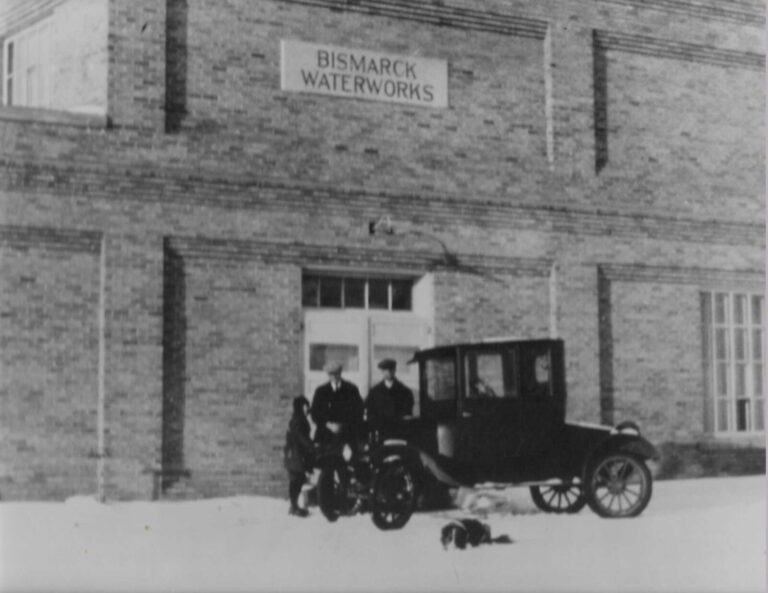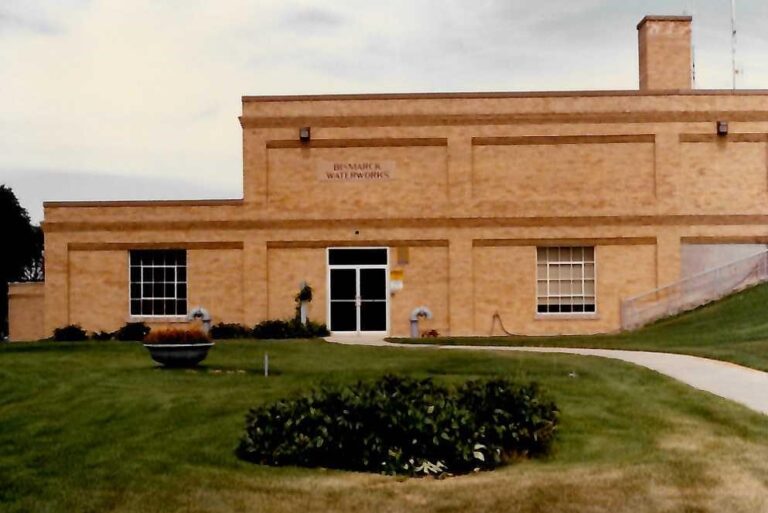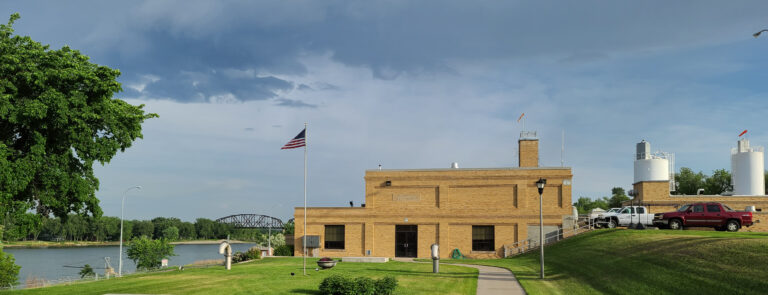State Legislators Award $50 Million to City of Bismarck’s Public Works Infrastructure
By Mike Schmitz
Water is the building block on which civilization is built. Without water, there are not enough resources to keep a large group of people alive for any longer than a few days. Sanitation would be impossible. There are no jobs, there are no commercial entities, there is no growth. Every state, county, and city in the United States is dependent on water.
In Bismarck, the dependence on water leads you to the Missouri River, a gigantic stretch of water that travels 2,300 miles from Montana to Missouri, where it connects with the Mississippi River. While a North Dakota city relying on a water source often called “The Big Muddy” due to the sediment that can accumulate may not seem like a worthwhile proposition, the Missouri River has helped the community proposer for more than 150 years.


Camp Greeley was established along the river’s banks in 1872, serving as a supply depot for forts along the river. The camp grew and a year later its name was changed to Camp Hancock. The city, originally called Edwinton, was renamed Bismarck in 1873. Many of the city’s water services sprung from the treatment plant’s finished construction in 1924. Parts of that initial infrastructure still play a part in the services citizens receive today.
Bismarck has grown from those humble beginnings to a community of about 75,000 people, North Dakota’s Capital City, and the state’s second-largest city overall. The community appears to have reached a sustainable growth threshold, as it grew by an estimated 20 percent between 2010 and 2020 and is expected to reach 100,000 people by 2045.
However, the footprint that comes with that growth is considerable. Presently, Bismarck has an area of just over 1 billion square feet, or just below 36 square miles. That is up from 26 square miles (725,775,986-square-feet) in 2000, 30.5 square miles (851,213,234-square-feet) in 2010, and 35.1 square miles (978,904,187-square-feet) in 2020.
But with growth comes the need for more services and a larger reach for existing services. The systems that were established initially had different capabilities and were in place for different needs. The capabilities in place for decades can be stressed beyond capacity and the threat of breakdown if not maintained. During summer months, as the need for water is at its highest, overextending the city’s water system could result in the absence of water.
The Need
The City’s growing footprint continues to drive costs when it comes to services for citizens. In the winter, for example, more roads means that it takes longer to remove snow. As new neighborhoods are established, trees may not yet be mature and unable to slow the blowing snow from building in certain areas. When it comes to water treatment, water distribution, sanitary sewer, wastewater treatment, and stormwater management, the process of moving water is necessary to maintain a safe and thriving community.
The City’s Public Works Utility Operations exist as an enterprise fund. Enterprise funds are self-supporting government fund that sells goods or services—in this case, drinking water, sewer, and stormwater services— to the public. The cost of the service will determine the cost to the customers, and as the cost of service goes up, so will what customers pay.

“Our challenge is to provide high-quality services to citizens, every day, and at all hours,” said Public Works Utility Operations Michelle Klose. “When someone is without one of the services that Utility Operations provide, it becomes apparent very quickly how difficult life is without access to water.”
While residential usage ranges across consumption, bathing, lawn and garden care, and other needs, non-residential use is often more widely varied. These non-residential entities serve as critical foundations for a strong community and are important building blocks for the future of Bismarck:
• Medical Facilities (i.e. hospitals, clinics, etc.)
• Industrial Users (i.e. construction, manufacturing facilities, etc.)
• Hotel Industry
• Food & Beverage Services (i.e. restaurants, bottling companies, breweries, etc.)
• Parks & Rec (i.e. swimming pools)
• Schools (elementary through college)
To show how much demand has increased in just the last decade, consider the volume of utility billing accounts: In 2013, the City of Bismarck maintained a network of 11,456 utility billing accounts. That number grew to 16,367 in 2018. In 2023, the amount of billing accounts has more than doubled from the 2013 mark and is at 23,266. The City of Bismarck’s utility infrastructure needs were estimated to be just shy of $200 million on a story map that Public Works Utility Operations created in 2022 to serve as a roadmap of sorts through the needed infrastructure improvements:
• $83 million: The City’s Water Treatment Plant is 100 years old in 2024 and still contains some original infrastructure in place today. This project will improve piping, pumping and increase water treatment capacity from 30 to 40 million gallons per day.
• $23.5 million: The City’s Wastewater plant treats 6.5 million gallons of wastewater every day. This project will improve treatment processes and ensure federal clean water compliance.
• $36 million: Watermains in the City’s Water Distribution System are reaching 100 years in service. This project will be needed for repairs and replacement of these mains and storage will project and ensure delivery of safe drinking water.
• $55 million: The City’s Sanitary Sewer System collects wastewater from nearly 23,000 customers, through a 300-mile network of sewers and 23 lift stations. This project will provide upgrades to the Pioneer and Hay Creek lift stations.
• $6.3 million: the City’s stormwater system collects drainage and carries it to the Missouri River and its tributaries. This project will help augment the pipe and culverts that help prevent flooding by holding back high flows during large runoff Events.
Financial Philosophy Change
The City of Bismarck has historically not sought out funding through legislative sessions. Prior to 2023, the city instead paid for projects through money raised through fees, taxes and assessments, and state funding was traditionally unused. However, facing the enormity of these combined projects prompted a need to change that philosophy.
This change would happen during the state’s 68th Legislative Session. During this session, Senate Bill 2020 was introduced as a way for the Department of Water Resources to defray the expenses to infrastructure. However, early versions of this bill initially did not include the $50 million that Bismarck would eventually be awarded. Following testimony by the City of Bismarck $30 million of funding was identified for the Bismarck Water Treatment Plant expansion project. Testimony was provided to the House Appropriations Committee and an additional $20 million of funding was added.
“Bismarck is lucky we have a good delegation that works very well together and worked hard to get the funding for Bismarck’s water infrastructure needs,” said City Administrator Keith Hunke. “Having Bismarck legislators seated on important committees also helped us to be successful in navigating the legislative process.”
Part of what made the testimony compelling for the legislature is that Bismarck’s Water Treatment Plant no longer provides water only to the city, but is instead a regional water provider. Drinking water that is produced through the City of Bismarck Water Treatment Plant is provided regionally to the South Central Regional Water District (8,000+ users), the City of Lincoln (4,300+ population), the University of Mary (3,800+ students/faculty), United Tribes Technical College (900+ students and faculty), along with the water distributed throughout the city of Bismarck.

“The information shared with legislators about our Water Treatment Plant expansion project and who we provide safe drinking water to, was key,” said Hunke. “It’s telling our story and consensus building— it’s working with both the Senate and the House, letting them know how this not only benefited Bismarck, but how it benefited the rest of the region.”
Following the amendments made to the first round of the bill, which included the addition of five lines of text that would equate to $50,000,000 for the City of the Bismarck, the House passed the bill by an 88-4 margin, while it passed the Senate 46-0 on April 28 and was signed by Governor Doug Burgum on May 8. In total, Senate Bill 2020 is responsible for providing a total of $892 million for projects.
“This historic investment in water supplies, flood control, and water management will support community growth and resiliency, enable economic expansion, and provide tangible benefits to North Dakotans across our state for generations to come,” Burgum said. “We’re deeply grateful for the work by the Legislature, DWR, State Water Commission, regional and local water managers, and other stakeholders who highlighted the needs and helped to move this critical infrastructure funding across the finish line.”
Funding Impacts
The benefit from the $50 million dollars in funding is three-fold for the City of Bismarck, if not more. The first benefit has to do with receiving the money, and that money received will help pay for the Utility Operations projects. This benefit is fairly straightforward—there was a need and this funding will help address that need. The projected water consumption for a growing population will be met for years to come.
“To not expand the Water Treatment Plant to meet our peak demands forecasted through 2040 would be a devastating blow to our community’s growth,” said Hunke. “The $50 million would have had to have been all placed on our water customers which would have created unreasonable and mostly unaffordable water rates.”

One of the most interesting concepts about money is value. Outside of the value, or worth, money has today, there is the expected value of money tomorrow or a year from today. And while you can project that value, no one really knows what it will be until that day. But, the general consensus is that projects two years from now will be more expensive than projects today. Subsequently, there is additional value in having all of the money on hand to pay for a project. This has become especially apparent during the supply chain issues that have plagued the country since the COVID-19 pandemic, creating additional financial pitfalls. However, because the funding from the state is accessible as project costs occur, the project is able to proceed at a faster rate than what was initially anticipated. Klose estimated that the Water Treatment Plant project timeline was able to be accelerated by 24 months. By speeding up that timeline, a number of costs can be mitigated because the payments are happening now, and now at inflation-effected prices two years down the road.
The third positive impact because of this funding is the monthly fees that Bismarck citizens pay each month. The infusion of $50 million means that utility rates were able to be stabilized.
Looking Ahead
The future of Bismarck continues to be a bright one. By increasing the Water Treatment Plant’s ability to produce another 10 million gallons of drinking water each day, the expected water need for the City should be met through the majority of the next two decades.

But for a growing city, when one project is completed, another one traditionally takes its place. And there is no shortage of upcoming projects for the City of Bismarck. Accompanying these infrastructure changes and improvements are additional projects. This fall, Public Health will enter a new dedicated building, located just to the north of the Public Works facility on 26th Street, in Bismarck. In the near future, a fire station will be built in Northeast Bismarck. Soon, a new police station will need to be built. More roads will be needed to help get people from east to west, north to south. The needs for a growing city do not slow.
Through the identification of need, collaboration of thought, and the willingness to address these challenges with traditional and innovative responses, the stage is set for Bismarck to continue its measured and sustainable rise.


